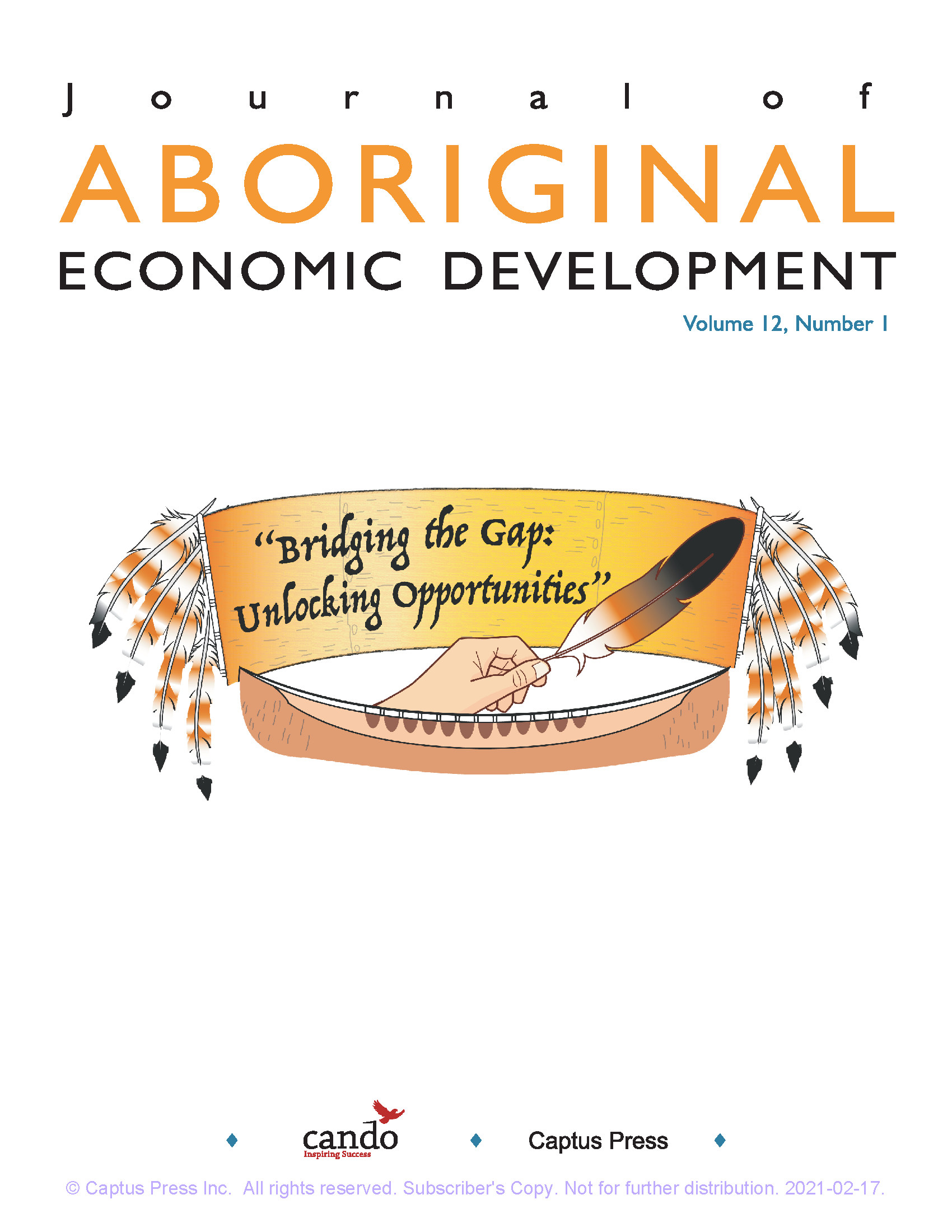A Modern Annuity for Canada: Concrete Reconciliation
DOI:
https://doi.org/10.54056/ALBS4958Keywords:
19th century, Agreements, Annuities, Business And Economics, Compensation, Costs, Ethnic Interests, Fishing, Hunting, Indigenous peoples, National reconciliation, Native North Americans, Preservation, Reconciliation, Settlers, TreatiesAbstract
Canada's history features many commercial compacts, agreements, and treaties marking the evolution of the relations between Indigenous Peoples and Settlers. The treaties negotiated between 1850 and 1921 comprised three main elements: the allocation of land for the exclusive use of the signatory First Nations; preservation of hunting and fishing rights; and an individual annuity paid to each band member, plus a one-time payment made to the band. The individual annuity was minimal, even in the later 19th century, and has remained unchanged since 1878. This paper explores the rationale, design, implementation, and cost of a Modern Annuity as the concrete measure for reconciliation, acknowledging the value of the land ceded to Canada by the Indigenous peoples.
Downloads
References
Anderson, E. (2010). The treaty annuity as livelihood assistance and relationship renewal. Aboriginal Policy Research International (APRCi), 74. https://ir.lib.uwo.ca/aprci/74
Ash, M., & Zlotkin, N. (1997). Affirming Aboriginal Title: A new basis for comprehensive claims. In Michael Ash (ed.), Aboriginal and treaty rights in Canada. Vancouver: UBC Press.
Béland, D., & Daigneault, P.-M. (2015). Welfare reform in Canada: Provincial social assistance in comparative perspective. Toronto: University of Toronto Press.
Canada, Parliament, House of Commons. (1878). Debates, 3rd Parliament, 5th session (March 26), p. 2141
Canada. (1996). Report of the Royal Commission on Aboriginal Peoples. http://www.bac-lac.gc.ca/eng/discover/aboriginal-heritage/royal-commission-aboriginal-peoples/Pages/final-report.aspx
Canada. (2008). Comprehensive Claims [Administrative page]. https://www.rcaanc-cirnac.gc.ca/eng/1100100030577/1551196153650
Canada. (2009, February 10). Registered Indian demography — population, household and family projections, 2004–2029 [Report; statistics]. https://www.aadnc-aandc.gc.ca/eng/1100100016838/1100100016855
Canada. (2013a, February 15). Robinson Treaties and Douglas Treaties (1850–1854) [Reference material]. https://www.rcaanc-cirnac.gc.ca/eng/1360945974712/1544619909155#rt
Canada. (2013b, February 15). The Numbered Treaties (1871–1921) [Reference material]. https://www.rcaanc-cirnac.gc.ca/eng/1360948213124/1544620003549
Canada. (2015). Honouring the Truth, Reconciling for the Future: Final Report, Truth and Reconciliation Commission. https://www.rcaanc-cirnac.gc.ca/eng/1450124405592/1529106060525#chp2
Cardinal, H., & Hildebrandt, W. (2002). Treaty elders of Saskatchewan: Our dream is that our peoples will one day be clearly recognized as nations. Calgary: University of Calgary Press.
Chute, J. (2009). Moving on up: The rationale for, and consequences of, the escalation clause in the Robinson Treaties. Native Studies Review, 18(1), 14.
Craft, A. (2013). Breathing life into the Stone Fort Treaty: An Anisinabe understanding of the Treaty One. Sasktoon: Purich Publishing Ltd.
Farm Credit Canada. (2018). 2018-FCC farmland values report. https://www.fcc-fac.ca/fcc/about-fcc/reports/2018-farmland-values-report-e.pdf
Gunn, K. (2018). Agreeing to share: Treaty 3, history & the courts. U.B.C. Law Review, 51(1), 75–104.
Hall, A.J. (2015). From Treaties to Reserves: The federal government and Native peoples in Alberta. Montreal & Kingston: McGill-Queens University Press.
Hall, A.J., Albers, G., & McIntosh, A. (2020). Royal Proclamation of 1763 | The Canadian Encyclopedia. Royal Proclamation of 1763. https://www.thecanadianencyclopedia.ca/en/article/royalproclamation-of-1763
Indigenous Services Canada. (2018). Registered Indian population by sex and residence 2016 (Catalogue: R31-3E-PDF QS-6308-030-EE-A1). Government of Canada. www.canada.ca/indigensous-services-canada
Jones, S. (2018). Treaty annuity right: The treaty right no one wanted to talk about. Until now. Frontier Centre For Public Policy Backgrounder, No. 124, 9.
Jones, S. (2019). Let the people speak: Oppression in a time of reconciliation. Winnipeg: J. Gordon Shillingford Publishing.
Krasowski, S. (2011). Mediating the Numbered Treaties: Eyewitness accounts of treaties between the Crown and Indigenous peoples, 1871–1876 [Doctor of Philosophy, Regina]. http://ourspace.uregina.ca/handle/10294/3575
Krasowski, S. (2019). No Surrender: The land remains Indigenous. Regina, SK: University of Regina Press.
Leslie, J., & Baldwin, B. (2006). Indian treaty annuities: The historical evolution of government policy from colonial times to Treaty 3. Ottawa: Research and Analysis Directorate.
Manitoba. (1988). Assistance Regulation. Province of Manitoba— Families. https://www.gov.mb.ca/fs/eia_manual/regs/index.html
Manitoba. (2020). Assistance Regulation. Province of Manitoba— families. https://www.gov.mb.ca/fs/
McNeil, K. (1997). The meaning of Aboriginal title. In Michael Ash (ed.), Aboriginal and treaty rights in Canada. Vancouver: UBC Press.
Metcs, R. (2008). The common intention of the parties and the payment of annuities under the Numbered Treaties: Who assumed the risk of inflation. Alberta Law Review, 46(1), 41–76.
Miller, J.R. (2009). Compact, contract, covenant: Aboriginal treaty-making in Canada. Toronto: University of Toronto Press.
Ontario. (2018). Restoule v. Canada (Attorney General), 2018 ONSC 7701. http://caid.ca/ResDec2018.pdf
Prosper Canada, & AFOA Canada. (2018). Increasing indigenous benefit take-up in Canada. http://prospercanada.org/getattachment/f4add5df-0edb-4883-b804-60661f500c56/Increasing-Indigenous-benefit-take-up-in-Canada.aspx
Ray, A.J. (1990). The Canadian fur trade in the Industrial Age. Toronto: University of Toronto Press.
Robson, J., & Schwartz, S. (2020). Who doesn’t file a tax return? A portrait of non-filers. Canadian Public Policy. https://doi.org/10.3138/cpp.2019-063
Statistics Canada. (August 22, 2014). An overview of Canada’s Consumer Price Index (CPI) (Catalog. No. 11-629–x). https://www.statcan.gc.ca/eng/sc/video/cpi
Statistics Canada. (2018, February 20). Gross domestic product price indexes, quarterly (Table: 36-10-0106-01). https://www150.statcan.gc.ca/t1/tbl1/en/tv.action?pid=3610010601
Statistics Canada. (2019a). Consumer Price Index by product group, monthly, percentage change, not seasonally adjusted, Canada, provinces, Whitehorse, Yellowknife and Iqaluit (No. 18-10-0004–13). https://www150.statcan.gc.ca/t1/tbl1/en/cv.action?pid=1810000413
Statistics Canada. (2019b). Gross domestic product (GDP) at basic prices, by industry, monthly, growth rates (No. 36-10-0434–02). https://www150.statcan.gc.ca/t1/tbl1/en/tv.action?pid=3610043402
Statistics Canada. (2021). Projections of the Aboriginal population and households in Canada 2011 to 2036 (Catalogue no. 91-552-X). https://www150.statcan.gc.ca/n1/pub/91-552-x/91-552-x2015001-eng.pdf
Supreme Court of Canada. (1999). R. v. Marshall, [1999] 3 S.C.R. 533.
Supreme Court of Canadas. (1973). Calder et al. v. Attorney-General of British Columbia, [1973] S.C.R. 313. https://scc-csc.lexum.com/scc-csc/scc-csc/en/item/5113/index.do
Surtees, R.J. (1983). Indian land cessions in Ontario 1763–1862: The evolution of a system [Carleton University]. https://curve.carleton.ca/2715b1bf-f421-4566-90b6-177939471d8d
Surtees, R.J. (1986). Treaty Research Report, The Williams Treaties (1923). https://www.rcaanccirnac.gc.ca/eng/1100100029000/1564415701529
Venne, S. (1997). Understanding Treaty 6: An Indigenous perspective. In Michael Ash (ed.), Aboriginal and Treaty Rights in Canada. Vancouver: UBC Press.
Vidal, A., & Anderson, T.G. (1850). Report on the Robinson Superior Treaty of 1850 (Vidal And Anderson Report, 1849). Ontario Archives. https://archive.org/details/VidalAndAndersonReport1849/page/n8/mode/2up
Downloads
Published
Issue
Section
License
Copyright (c) 2020 Cando

This work is licensed under a Creative Commons Attribution-NonCommercial-NoDerivatives 4.0 International License.




